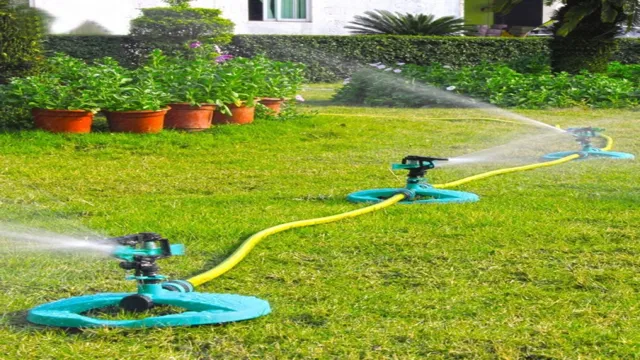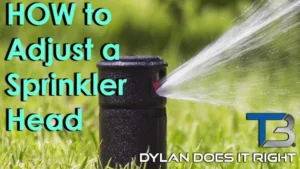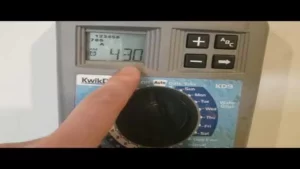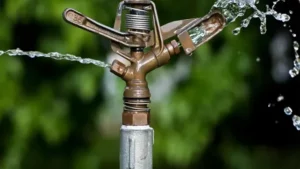When it comes to keeping your lawn looking its best, a sprinkler system is a valuable tool. But while ensuring your grass and plants are adequately watered is important, it’s also essential to optimize your sprinkler usage. One of the most crucial factors in this regard is knowing how long to run your system.
Too little water, and your lawn will dry up and die off. But too much water can be equally damaging, as it can lead to root rot and other harmful plant diseases. So, how can you know how long to run your system to achieve the best results? Let’s take a closer look at the factors you should consider when answering this question.
Understanding Your Sprinkler System
If you’re wondering how long you should run your sprinkler system, the answer isn’t as straightforward as you might think. There are a variety of factors that can influence the amount of time your system should be on, such as the type of plants in your garden, the weather conditions, and the type of sprinkler heads you have. Generally speaking, most lawns and gardens need about an inch of water per week.
This can be accomplished either by running your sprinkler system once a week for an hour or by breaking it up into two shorter sessions throughout the week. However, it’s important to keep in mind that different types of soil may require different watering schedules, so you’ll want to do some research to determine what works best for your specific lawn or garden. Ultimately, the key to a healthy lawn or garden is consistency, so whatever schedule you choose, make sure to stick with it!
Sprinkler System Basics
A sprinkler system is a vital installation for keeping your lawn or garden healthy and vibrant, but understanding how it works can be confusing. Essentially, a sprinkler system consists of a network of pipes that are connected to water sources like a home’s main water line. Each pipe is outfitted with a series of sprinkler heads that distribute water evenly across the area being irrigated.
The water is controlled by an electronic timer that can be programmed to adhere to a specific schedule. By having a sprinkler system installed on your property, you’ll be able to save time and water, as well as ensure that your lawn or garden receives the proper amount of hydration to keep it looking its best. It’s important to keep your sprinkler system well-maintained to avoid leaks or malfunctions, but with a little regular attention, you can enjoy the many benefits of this convenient and efficient irrigation method.
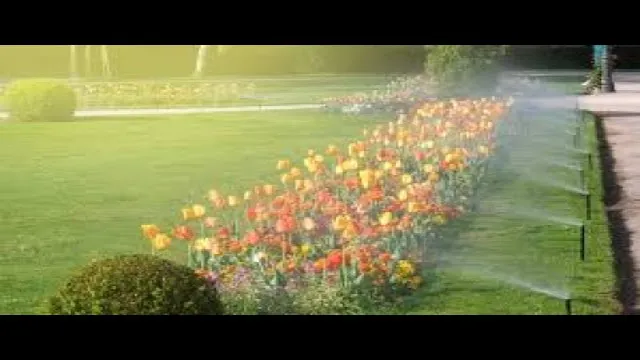
Factors Impacting Run Time
When it comes to your sprinkler system, there are multiple factors that can impact its run time. Understanding these variables can help ensure that your lawn is being watered efficiently and effectively. One key factor is the type of sprinkler heads you have.
Different sprinkler heads have varying rates of precipitation, which can affect how long they need to be on for to effectively water the lawn. The shape and size of your lawn can also impact run time. Certain areas may require more water due to sun exposure, soil type, or slope.
Additionally, the water pressure and flow rate of your system can greatly impact how long it takes to water your lawn. It’s important to regularly check your system for leaks or clogs, as these issues can also impede water flow and lead to longer run times. Lastly, your programming settings can impact run time.
Many sprinkler systems have the option to set a specific duration and frequency for watering. It’s important to select the optimal settings based on your lawn’s specific needs. Overall, by considering these factors and regularly maintaining your system, you can ensure that your lawn is receiving the appropriate amount of water without wasting resources.
Determining Your Ideal Run Time
If you’re wondering how long should you run your sprinkler system, the answer isn’t straightforward. The ideal run time for your sprinkler system depends on several factors, such as the climate and the type of soil in your yard. Ideally, you should aim to water your lawn between 1 to
5 inches per week, including rainfall. This amount can be divided up into two or three waterings. An excellent way to determine how long you should run your sprinkler system is to perform a catch can test.
This test involves placing several containers under your sprinkler’s spray and measuring the amount of water collected in 30 minutes. Based on the results, you can adjust your sprinkler’s run time to ensure proper coverage and adequate water distribution. Remember, watering too little can lead to a dry, unhealthy lawn, while overwatering can be just as damaging, causing mold growth, root rot, and increased weed growth.
Measuring Water Output
When it comes to figuring out the ideal run time for your irrigation system, it all comes down to measuring water output. Knowing how much water your system is dispersing can help you determine the appropriate amount of time to run your sprinklers. One way to measure water output is by using a rain gauge or a straight-sided container placed in the middle of the sprinklers’ coverage area.
Turn on the system and let it run for a set amount of time, then measure the amount of water collected in the container. From there, you can calculate the average water output per hour and determine how long you need to run the system to achieve your desired depth of water. By taking the time to measure your water output, you can optimize your irrigation system to ensure that your lawn or garden receives the right amount of water without wasting any.
Calculating Coverage Area
Calculating Coverage Area If you’re considering purchasing a wireless access point for your business or home, deciding on the coverage area is crucial. Determining the ideal runtime of your access point is an essential part of calculating the coverage area you need. The ideal runtime is the amount of time a wireless device can power on its battery.
To calculate your coverage area, you must consider the number of devices that will use the Wi-Fi and their typical usage. You must also determine the ideal battery life of your devices or access points. With this information, you can multiply the number of devices by their ideal runtime to find the total number of hours needed.
This calculation can assist you in selecting the most appropriate wireless access point for your business or home. By determining your ideal run time, you’ll be able to ensure that your Wi-Fi has the correct area coverage to meet your needs.
Factoring in Local Weather Conditions
When deciding on the best run time, it’s important to factor in local weather conditions. Running in extreme heat or cold can lead to exhaustion or even health complications, so it’s essential to plan accordingly. Begin by checking the forecast before heading out and adjust your run time accordingly.
If it’s going to be particularly hot or humid, try to run during the cooler morning or evening hours. In contrast, if it’s cold outside, it’s best to wait until later in the day when the temperature has warmed up a bit. Paying attention to the weather can ensure a more comfortable and safer running experience.
Maximizing Water Efficiency
Water efficiency is essential in keeping your lawn healthy, lush, and green. But how long should you run your sprinkler system to ensure maximum efficiency? The answer will depend on various factors like the type of soil, weather conditions, and the type of grass you have. Generally, it’s best to water your lawn deeply but infrequently.
This means watering your lawn for longer periods but less frequently, like once or twice a week, depending on the weather. On average, it would take about 30 minutes to an hour to water your lawn deeply. However, if you have sandy soil, a shorter watering time of 20 to 30 minutes may be appropriate.
It is also crucial to know the municipal watering regulations in your area as these may dictate how long you are allowed to water your lawn. By knowing how long to run your sprinkler system, you can maximize water efficiency while maintaining a beautiful and healthy lawn.
Implementing Water-Saving Techniques
Implementing water-saving techniques is crucial for maximizing water efficiency, especially in areas with limited water resources. There are many ways in which we can save water, alleviate pressure on local water supplies, and reduce water bills. One popular way is to use low-flow fixtures like faucets, showerheads, and toilets, which can help to save thousands of gallons of water every year.
You can also opt for a water-efficient washing machine, dishwasher, and gardening tools to minimize water usage. Another water-saving technique is to capture rainwater, which can be used for irrigation and watering purposes, further reducing the need for tap water. By implementing these techniques, we can all play our part in conserving water and maximising water efficiency, helping to safeguard our precious water resources for future generations.
Choosing the Right Sprinkler Heads and Nozzles
When it comes to maximizing water efficiency, choosing the right sprinkler heads and nozzles is crucial. One of the key factors to consider is the flow rate. High flow rate heads can cover larger areas, but also result in greater water waste.
On the other hand, low flow rate heads conserve water, but are better suited for smaller areas. Additionally, there are different types of nozzles that affect water distribution. Fixed spray nozzles are ideal for precision watering, while rotating nozzles cover larger areas in a more even pattern.
It’s important to evaluate your specific lawn’s needs and choose a system that will deliver water evenly and without waste. By making informed choices about your sprinkler system, you can conserve water and save money in the long run.
Conclusion and Action Steps
In the end, the decision of how long to run your sprinkler system ultimately depends on a variety of factors, including the time of day, weather conditions, and the type of plants in your yard. However, one thing is certain – by finding the perfect balance between water conservation and plant health, you’ll be able to keep your lawn looking lush and beautiful for years to come. So, whether you prefer to set a timer or simply rely on nature’s cues, remember that every drop counts when it comes to keeping your lawn green and healthy.
Happy watering!”
FAQs
How often should I run my sprinkler system?
It depends on factors such as soil type, weather conditions, and plant needs. However, a general guideline is to run your sprinkler system 1-2 times per week for about 20-30 minutes each time.
Can I set a timer on my sprinkler system to run automatically?
Yes, most modern sprinkler systems have a timer feature that allows you to set the days and times for the system to run. This can save you time and make sure your lawn or garden is consistently getting adequate water.
Should I adjust my sprinkler system based on the season?
Yes, it’s a good idea to adjust your sprinkler system based on seasonal changes. For example, in the summer when it’s hotter and drier, you might need to run your sprinklers more often. In the fall, you might need to decrease the frequency as the weather cools down and there’s more rainfall.
How do I know if I’m watering my lawn or garden too much or too little?
A good rule of thumb is to check the soil about 6 inches deep. If it’s wet, you may be watering too much. If it’s dry, you may need to increase the watering time or frequency. You can also look for signs of over or under watering such as yellowing leaves, wilting plants, or standing water.
Can I water my lawn or garden at any time of day?
It’s best to water your lawn or garden in the early morning or late evening when the temperatures are cooler and there’s less evaporation. Watering during the middle of the day can lead to more water loss due to evaporation.
How can I conserve water while still keeping my lawn or garden healthy?
Consider using drought-tolerant plants, adding mulch around your plants to retain moisture, and fixing any leaks or broken sprinkler heads. You may also want to look into installing a rain sensor to automatically turn off your sprinkler system when it’s raining.
How do I winterize my sprinkler system?
It’s important to turn off the water supply to your sprinkler system and drain any remaining water to prevent freezing and potential damage. You may also want to insulate any exposed pipes or valves. Consider hiring a professional to help with winterization.
